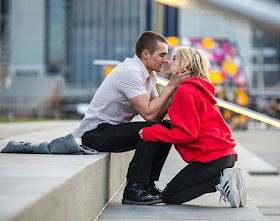Oh, yeah -- and it's a lot campier, too. TrustMovies was not much a fan of Joe Begos' earlier work, Almost Human, released in winter 2014 and dealing with an extraterrestrial kidnapping/returning that leads to a near-continuous slasher-movie massacre, so he is happy to report that he enjoyed Begos' latest film a lot more. THE MIND'S EYE involves telekinesis, which appears to be a subject that this writer/director (shown below) can have some fun with, while being a bit more creative and still get to those juicy/bloody/gory parts he clearly loves so much.
Our hero (this time, as last) is played by Graham Skipper (shown below, right), an actor of somewhat protuberant eyes, who pops them and bugs them almost consistently throughout the film. He undoubtedly was asked to do so by his director, as was his leading lady, Lauren Ashley Carter (below, left) because this eye-bugging is how all the telekinesis takes place. Time and again throughout the film, actors bug their eyes and pop their neck veins as their characters attempt to levitate and/or move everything from guns and furniture to hypodermic needles and a very nasty ax.
Trust me: you will not have seen so much eye-rolling and -popping since the last time you watched a silent movie -- and I think you'll agree that, even then, The Mind's Eye beats out those "silents" by a mile. And because it turns out that just about every character in the film is capable of this telekinesis, there is an awful lot of eye-popping going on.
Our hero (above), however, turns out to be almost the best of the bunch (think of him as a kind of hairy Carrie), although his girlfriend (below) nearly matches him by exploding a bad guy's head. Of course, all this take so much pain and intensity that you can expect to see lots of blood oozing from the telekinetics' various orifices.
Mr. Begos has managed to provide a more interesting screenplay, plot and even better dialog this time around, and so ropes us into his tale of a supposedly government-sponsored "home" for telekinetics run by a power-hungry nut case (John Speredakos, below) who goes from a cajoling nice-guy to a Freddy Krueger-style villain in no time flat. Also in the cast is the always-game Larry Fessenden, playing our hero's helpful police-officer father.
As the eyes pop and the blood flows, so, too, do the laughs grow louder and more frequent. I would like to think that this was part of Mr Begos' initial plan, and that he does not take himself or his movie all that seriously. The Mind's Eye is finally good, silly, noisy, campy fun. And don't let anyone tell you otherwise.
From RLJ Entertainment and running a blessedly short 87 minutes, the movie opens this coming Friday, August 5, simultaneously in theaters (a very limited release, I would assume), on iTunes and via VOD -- with a Blu-ray disc release scheduled for Tuesday, October 4,

















































